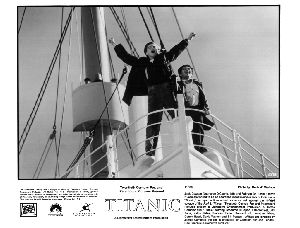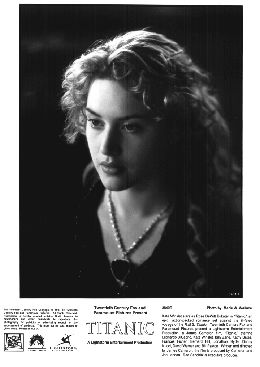click for new |
 |
| Festivale online magazine, January, 1998 |
| Titanic - a powerful voice from a watery grave
It was the largest object humans had ever put to sea. It was built by and for the generation who remembered the 'naughty nineties' and 'the war to end all wars'. They were proud, mechanistic, and strong in their belief that humans ruled the universe, a universe made for them.
This unsinkable ship was a symbol of humans conquering the elements with mathematics and engineering and money. Depression, prohibition and the great crash were not even specters in their futures as the world watched in wonder at the launch of the seaborne Titan - a mythic figure made not by gods, but by humans. |

Photo: Merie W. Wallace |
| "My goal in making this film," said writer/director James Cameron, "was to show not only the dramatic death of this infamous ship, but her brief and glorious life as well. To capture the beauty, exuberance, optimism and hope of Titanic, her passengers and crew and, in the process of baring the dark side of humanity underlying this tragedy, celebrate the limitless potential of the human spirit. For Titanic is not just a cautionary tale -- a myth, a parable, a metaphor for the ills of [humanity]. It is also a story of faith, courage, sacrifice and, above all else, love." |
|
"The tragedy of Titanic", according to Cameron, "has assumed an almost mythic quality in our collective imagination. But the passage of time has robbed it of its human face and vitality. I hope that Rose and Jack's relationship will be a kind of emotional lightning rod, if you will, allowing viewers to invest their minds and their hearts to make history come alive again. Their connection on an emotional level is what transforms Rose from this sort of Edwardian first-class geisha who is dying on the inside into this spirited young woman on the cusp of a new life. Jack possesses this natural energy and purity of spirit which makes that transformation possible." |
| The power of this film comes from realism in human portrayals, and in the portrayal of the ship and the lifestyle it represented. Cameron says, "We wanted to tell a fictional story within absolutely rigorous, historically accurate terms. If something is known to have taken place, we do not violate it. Likewise, there's nothing that we show that could not have happened. Our fictitious characters are woven through the pylons of history in such a way that they could have been there. All the accuracy and all the special visual effects are intended for one purpose: to put the viewer on the Titanic. It's a very you-are-there kind of experience." Titanic experts Don Lynch and Ken Marschall (Titanic: An Illustrated History) were profoundly moved to be on the deck of the recreated Titanic, seeing the subject of years of study in colour, and feeling it under their feet. Cameron, who took cast and crew under water for The Abyss, was not content to create and walk the deck of his own Titanic, he travelled to the Titanic's grave 400 miles off the coast of Newfoundland and two-and-a-half miles below the surface. Cameron and his team broke new ground, filming the Titanic with a specially-developed camera system, able to pan and tilt, with wide-angle lenses and capable of withstanding the cold and 6,000 pounds per square inch of pressure. The project required customised titanium housings for the camera and for the lighting system. The restrictions of the equipment meant that the crew spent 16 hours travelling down to the Titanic and back, with only 12 minutes of film in the camera.
|
|
The experience of actually filming the wreck, of being there informs the actions of the film's characters. The salvage crew who viewers watch in the opening sequences mirror the journey of the Cameron's film crew. Of the experience, Cameron says, "I went there as a director... it wasn't until the third or fourth dive that I let it hit me emotionally -- the awe and mystery of being two-and-a-half miles down on the floor of the Atlantic, seeing the sad ruin of this great ship." "We sent our remote vehicle inside and explored the interiors. We literally saw things that no one has seen since 1912, since the ship went down. We've integrated these images into the fabric of the film, and that reality has a profound impact on the emotional power of the film." The footage shot in the wreck of the Titanic was used when building the sets used in the film, says Cameron, "When you see the interior and exterior of Titanic in this film, it is absolutely accurate. It is as close as you can get to being in a time machine, going back and being on that ship." |

|
| In the brief weeks since the release of this film, there has been a flood of emotion from the audiences. Viewers have left the theatres, often tear-stained, and sought to continue the experience on the web. The sinking of the Titanic in 1912 was a blow to human hubris, it struck at the core of our belief in the engineers in whose hands we daily place our lives. It took the hopes and dreams of thousands to a watery grave with the hundreds of lost passengers. | |
 Photo: Merie W. Wallace |
Here in the future, we are struck once again by the inescapability of the power of the universe. Ultimately we are all adrift on a ship that we despoil daily, our very lives depend on the quality of the good ship Earth, and while we may take time out to enjoy her bounty now and again, we do not inform ourselves, we do not rise up and demand better protection, and we know, that on this day, at this time, if the Earth sinks there are no lifeboats. Writer James Cameron reminds us, "They thought that they were lords of the sea. They thought they had dominated nature. But nature will never be dominated. We have to ride with it, but we're not going to steamroll right over the top of it. They thought they could pave the world and drive their big, metal ships across the ocean with impunity. They were wrong."
See also: Titanic info page |
| The cost of the ship, R.M.S Titanic was approximately $7.5 million in 1912. when this story was filed, the film has taken $156 million at the box office, $13 million in Australia. |
|
Like us on facebook |
No other uses are permitted without the prior written consent of owner. Use of the material in violation of the foregoing may result in civil and/or criminal penalties. Celebrate everything! www.festivale.info ISSN 1328-8008 Published in Melbourne, Victoria, Australia disclaimers | contact the editor | Festivale revision history  Published in Melbourne, Victoria, Australia Published in Melbourne, Victoria, Australia  copyright © Festivale 2009 All rights reserved copyright © Festivale 2009 All rights reservedFiled: January 10, 1998 Entire site refreshed: Dec 2008-Feb 2009 | Site URL transferred: Jan 2005 (previously www.festivale.webcentral.com.au) |

